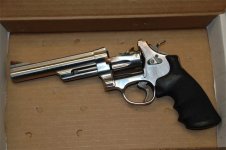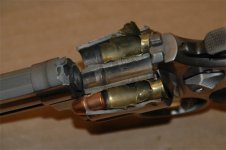I have a 1916 .455 HE converted to .45ACP. All over the internet people warn not to shoot factory .45 ACP in these because it has substantially higher pressure than the .455. I also have a U.S. 1917 HE designed to fire .45 ACP. Did S&W intentionally make the .455s out of weaker steel than the 1917s just one year apart. I doubt it. Plus the .455s have a larger bore, shooting .451 .45ACPs should lower the pressure even more. So, any danger problem with .455s converted to .45 ACP?
You are using an out of date browser. It may not display this or other websites correctly.
You should upgrade or use an alternative browser.
You should upgrade or use an alternative browser.
Converted .455/.45ACP
- Thread starter andorra
- Start date
Register to hide this ad
It may be a cylinder heat treatment issue.
austintexas
Member
I have a 455 that went back to S&W in 1929 and was converted to 45 Colt and had target sights installed and I've never had an Issue with it.
SWCA 892
SWCA 892
The U S Government mandated that the S&W 1917 revolvers be heat treated.
The .45 Colt cartridge generates lower pressure than the .45 ACP.
The .45 Colt cartridge generates lower pressure than the .45 ACP.
Last edited:
While, I have never heard of a 455 cylinder converted to 45 acp blowing up. Perhaps those that did were well before the internet and are long forgotten. On the better safe than sorry side, a actual 45 acp cylinder that could be fit to your 455 would be easy to come by. Why not be sure.
455 pressure 13,000psi
45 colt pressure 14,000psi
45 acp pressure 21,000psi and +P 23,000psi
In fact I may have an spare acp cylinder in my cylinder pile as I have made a few into 45 colts. I know I have one that is set up to fire 45 colts and 45 acp in full moons
455 pressure 13,000psi
45 colt pressure 14,000psi
45 acp pressure 21,000psi and +P 23,000psi
In fact I may have an spare acp cylinder in my cylinder pile as I have made a few into 45 colts. I know I have one that is set up to fire 45 colts and 45 acp in full moons
Last edited:
StrawHat
Member
The 45 ACP working pressure is what the British used to proof the 455. The cylinders on the 455 were not heat treated.
Your revolver, your choice, your hands.
Kevin
Your revolver, your choice, your hands.
Kevin
Old Corp
Member
Many years ago, I had a Brit .455 HE that'd been converted to .45 Colt.
Shot it quite a lot, and had a friend who had access to some machining equipment, and he made me several ultra-thin half-moon clips for .45 ACP, so many, many .45 ACP rounds were fired in it also.
I did handload back then, but never tried to hotrod any rounds destined for that gun - not because I had even the remotest clue about older S&W's being heat treated vs. not, but simply knew it was old and to not push my luck.
So - most .45 Colt loads were approximately factory equivalent and most ACP ammo was what I shooting in my M1911 Series 70 at the time - cast 230 gr RNL hardcast with about 6 gr. of Unique. Approximately standard Ball ammo specs.
Never any problems.
Wish I'd kept it - it went away on a trade long before I caught the Smith bug......
Shot it quite a lot, and had a friend who had access to some machining equipment, and he made me several ultra-thin half-moon clips for .45 ACP, so many, many .45 ACP rounds were fired in it also.
I did handload back then, but never tried to hotrod any rounds destined for that gun - not because I had even the remotest clue about older S&W's being heat treated vs. not, but simply knew it was old and to not push my luck.
So - most .45 Colt loads were approximately factory equivalent and most ACP ammo was what I shooting in my M1911 Series 70 at the time - cast 230 gr RNL hardcast with about 6 gr. of Unique. Approximately standard Ball ammo specs.
Never any problems.
Wish I'd kept it - it went away on a trade long before I caught the Smith bug......
Last edited:
Baltimoreed11754
Member
Use target .45acp loads? I run light loads in all my cf revolvers because of arthritic swollen knuckles. No fun when it hurts.
Last edited:
Piwo
Member
I have one re-stamped "45 AR" on the barrel. I see no reason to subject a 100 plus year old non-heat treated gun to pressures it was not intended for. I have other guns for that. I use starting loads for 45 auto rim with .455 cast bullets in auto rim cases from an older Speer manual. I enjoy good accuracy and all the reasonable power one should expect from such an antique. It is not a "bear gun" or anything but a range queen. I simply love how that big, fat heavy bullet throws wooden blocks around and shatters them to pieces.
I also have one of these.
Have shot different factory loads through it with no issues. And accuracy is surprisingly good.
Like others I have a 1917 so it mainly get shot at the range.
But when the modification to acp was done they also cut the barrel back to 4 inches. Makes it a very handy revolver.
Have shot different factory loads through it with no issues. And accuracy is surprisingly good.
Like others I have a 1917 so it mainly get shot at the range.
But when the modification to acp was done they also cut the barrel back to 4 inches. Makes it a very handy revolver.
Shoot factory at your own risk. Personally, I hand-load 45 ACP to run at 700 fps with lighter bullets, resulting in much lower felt recoil, and they shoot just as well as factory ammo, but I feel very comfortable when shooting my loads in my 455.
Every 100+ year old 455 has endured an unknown life prior to the current owners and there is no telling what loads might have been shot through them, potentially weakening the steel or the mechanism. For example. just because somebody shoots 357 Magnums out of a Model 1902 with lengthened chambers is no reason to repeat such foolish behavior.
Even the strongest revolvers made can be destroyed. This Smith and Wesson Model 629 was said to be done by shooting Chinese .44 Magnum cartridges. Wonder if he is still happy that he saved a few bucks buying cheap ammo.


Every 100+ year old 455 has endured an unknown life prior to the current owners and there is no telling what loads might have been shot through them, potentially weakening the steel or the mechanism. For example. just because somebody shoots 357 Magnums out of a Model 1902 with lengthened chambers is no reason to repeat such foolish behavior.
Even the strongest revolvers made can be destroyed. This Smith and Wesson Model 629 was said to be done by shooting Chinese .44 Magnum cartridges. Wonder if he is still happy that he saved a few bucks buying cheap ammo.
Attachments
Brutal...............
How much would a .451 bullet through a .454 barrel reduce pressure? Perhaps enough to make a difference and reduce pressure to a much lesser number with the 45 ACP.
I would expect the pressure peak to be fairly close to the same. a lot less pressure is going to go by the sides of the bullet than out the barrel to cylinder gap and the resistance difference of a such a slightly under sized bullet to have little effect on initial pressure.
It isn't that I do not think your gun will handle a normal 45acp, it is that I doubt there is enough margin of error. It MAYBE fine forever, but maybe not.
Your gun is no longer original, why not get a real 45 acp cylinder for it. They are not that hard to find.
Last edited:
I have a 1916 .455 HE converted to .45ACP. All over the internet people warn not to shoot factory .45 ACP in these because it has substantially higher pressure than the .455. I also have a U.S. 1917 HE designed to fire .45 ACP. Did S&W intentionally make the .455s out of weaker steel than the 1917s just one year apart. I doubt it. Plus the .455s have a larger bore, shooting .451 .45ACPs should lower the pressure even more. So, any danger problem with .455s converted to .45 ACP?
No, S&W did not use "weaker steel" as you surmised. As posted above, the 1917 cyls were heat treated per the government contract requirement starting at about serial #16,000. (Note: All S&W cyls were heat treated by ~ 1920). All the .455 revolvers were completed before the plant was converted and specially tooled up to build only 1917s. So even if your .455 was built one day before that happened it would be built to the specs established in 1914, i.e., w/o heat treated cyls.
One must understand that shooting over pressure loads for a particular gun, like .45 ACP in a .455 does not necessarily cause catastrophic failure such as we see with accidental double powder charges, etc.
The damage is more of a cumulative nature. Such as developing stress cracks, premature cyl end play, and worst of all, cyl lock notches that bulge out from the chamber. Rendering cases impossible to extract/eject from the chambers. That's why we seldom hear about blown up guns, or cumulative damage which is seldom recognized or therefore reported.
Recognize that .45 AR (Auto Rim) cartridges were designed with lower pressures suitable for all revolvers chambered for ACP and w/o needing moon clips. They are in the same pressure range as 455 and 45 Colt, and safe for your gun.
The pressure reduction from shooting ACP bullets in a 455 Barrel is negligible and besides, maximum pressure is developed in the chamber before the bullet gets in the barrel. I would not depend on that to safely shoot ACP in my 455.
Last edited:
Baltimoreed11754
Member
Chinese made .44 Magnum? Any amoral country that has businessmen that run and own companies that have made poisoned baby formula cannot be trusted with anything and it’s products should be avoided like the monkey pox. They also like to use lead paint on children's toys.
Major 2
Member
and mercury in pet food.
Similar threads
- Locked
- Replies
- 5
- Views
- 1K
- Locked
- Replies
- 1
- Views
- 357
Latest posts
-
-
-
-
-
-
-
FINLAND - The Winter War 1939 -> NATO member 2023 - general matter about Finland
- Latest: S&WshooterFIN
-
-
-
-
-
-


